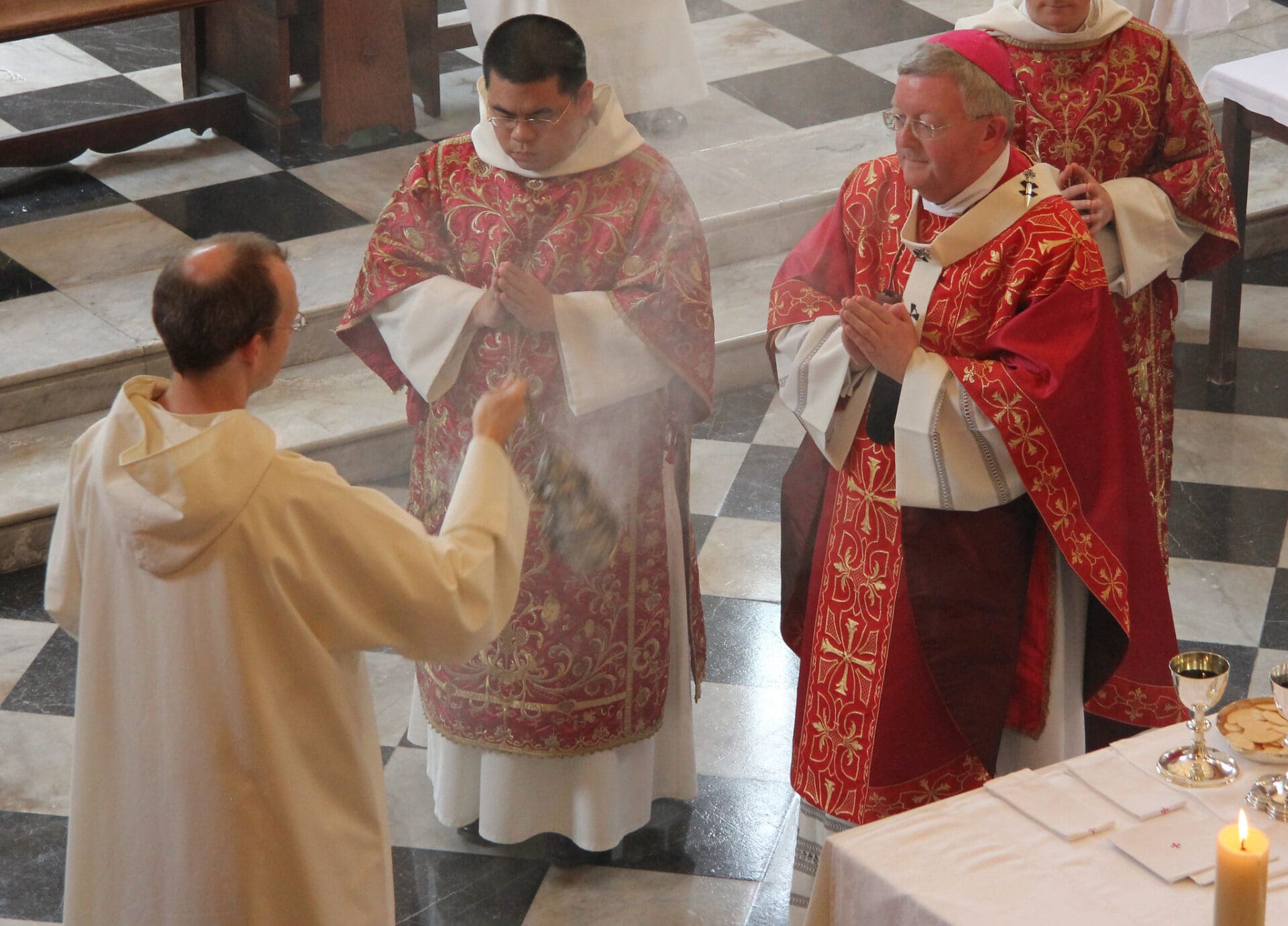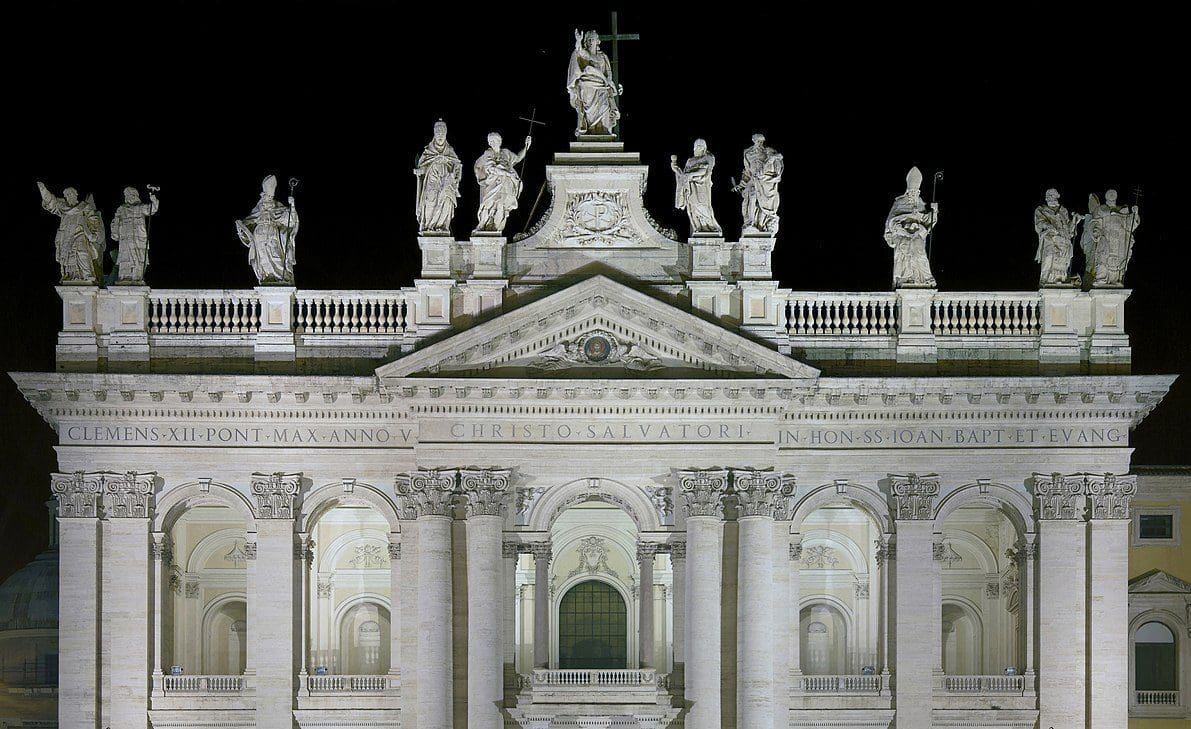For the purpose of trying to discern major shifts in the theory and practice of the reservation of the Blessed Sacrament, the history of the tabernacle can be divided into four sections: the patristic period until Carolingian times, the Carolingian period until the Council of Trent, the Council of Trent to Vatican II, and Vatican II to the present.
The Patristic Period until Carolingian Times1
The evidence from this early period deals with two kinds of reservation of the Blessed Sacrament: 1) the private reservation of the Eucharist in the homes of the faithful, and 2) the reservation of the Eucharist in the church for the sake of giving Communion to the sick or the dying.2
In the first category, the homes of the faithful, there is very little information about how or where the Eucharist was reserved, although some sources indicate that it was reverently wrapped in a piece of white linen, or placed in a special chest or container.3
In the case of the reservation of the Blessed Sacrament in churches, the Apostolic Constitutions, c.VIII, no. 13 indicate that the deacons should bring what was left over of the Eucharistic species consecrated during the Mass to a special room called the Pastoforio: in the Oriental churches, this was situated on the south side of the altar. In the West, it had the name secretarium or sacrarium.
The deacon had the keys, as the administration of the Eucharist was his special charge. In this room there was a special wardrobe or chest called a conditorium. An example of this can be seen in the fifth-century mosaics of the Galla Placidia mausoleum in Ravenna.4 In pre-Carolingian times, however, there is no evidence for the use of the altar as a place for the reservation of the Eucharist.5
From the ninth century onward, the reservation of the Blessed Sacrament in the church becomes the norm, while the practice of keeping the Eucharist in the homes of the faithful disappears. This is a one of those fundamental shifts that merits greater attention.
Giambattista Rapisarda offers three reasons for such a significant change in Eucharistic practice: 1) the rise of major Eucharistic controversies about the nature of Christ’s presence, starting with Paschasius Radbertus (+859) and Ratramnus (+868); 2) the spread of a different spirituality reflected in the new genre of apologetic prayers, which manifested enormous respect for the Eucharist and a sense of profound unworthiness before so great a mystery; and 3) the conversion of barbarian peoples en masse with the danger of profanation of the Eucharist on the one hand and superstition on the other.6
The Carolingian Period until the Council of Trent
The six or seven centuries we are dealing with in this second period contain notable developments in Eucharistic theology and practice. Mention must be made of Berengarius (+1088) and the Eucharistic controversy that raged around him; the development of a new Eucharistic piety manifested in the desire to see the Host, with the resultant introduction of the elevation first of the Host, then of the Chalice at the Consecration of the Mass; the scholastic precisions about transubstantiation; the diffusion of the feast of Corpus Christi; the decline in the reception of Communion, and so on.
Some of these factors contribute to new ways of reserving the Eucharist (the Sacrament-towers, for example). At other times, the force of custom results in the retention of more traditional forms. Righetti distinguishes five basic ways of reserving the Blessed Sacrament during this period:7
1) Propitiatorium: a container or small chest that was placed on the altar; hence a kind of portable tabernacle. The Fourth Lateran Council (1215-1216) prescribed that it should be locked and kept secure. This system was rather widespread in Italy in the thirteenth and fourteenth centuries.
2) Sacristy: In many places, the Eucharist was kept in the sacristy, in some kind of special chest or cupboard. In many places, this practice continued until the Council of Trent.
3) Eucharistic dove: around the eleventh century this system was used: a metal dove (symbolizing the Holy Spirit), hollow, of modest proportions, which was suspended over the altar from the ciborium (if there was one), or on a small table next to the altar. This system was frequently used in France and England, but rarely in Italy.
4) Wall tabernacles: From the thirteenth century onward this was the system most commonly used, especially in Italy and Germany, because it was more practical and more secure. On the Gospel side of the altar, a tabernacle was built into the wall. A fine example of such a tabernacle can be seen in San Clemente in Rome (thirteenth century). From the seventeenth century onward, with the development of the tabernacle on the altar, these wall tabernacles were then used to reserve the sacred oils.
5) Sakramentshäuschen or Sacrament-towers: This was a specialty of northern Europe (Germany, Low Countries, and northern France) from the fourteenth to the seventeenth centuries. It was usually in the shape of a tower, built close to the altar, the consecrated host kept in a glass container protected by a metal grate of some kind. This responded to the popular piety developing at the time: the desire to see the host. These “towers” were actually a kind of monstrance, with what amounted to permanent exposition of the Blessed Sacrament. One notes a great deal of variety according to time and place. At this time there is no standard practice for the universal Church.
The Council of Trent to Vatican II
What changed Catholic practice radically in this third period was the Protestant denial of the Real Presence of Christ in the Eucharist, and the response of the Counter-Reformation to this challenge. While the Council of Trent affirms against the Reformers that the Blessed Sacrament should be reserved,8 the canon in question is not very specific, mentioning the place of reservation in passing as the sacrarium.
Popular piety and two bishops will play an important role in establishing a new form of Eucharistic reservation. In the sixteenth century, even before the Council of Trent, Bishop Gian Matteo Giberti of Verona (+1543) ordered that the Eucharist should be reserved in a tabernacle on the main altar: “The tabernacle should be placed on the main altar, and should be installed permanently (bene et firmiter) in such a way that it can by no means be carried off by sacrilegious hands.”9
This eventually caught on in the neighboring diocese of Milan, such that in 1565, at the First Provincial Synod of Milan, it was decreed that: “The bishop should diligently see to it that in the cathedral, in collegiate churches, in parishes and all other kind of churches, where the most holy Eucharist is usually reserved or where it should be reserved, it be placed on the main altar, unless it seems to him otherwise, on account of some necessary or serious reason.”10
In 1576, another synod of Milan prohibited wall tabernacles, and ordered their destruction. Saint Charles Borromeo lent this new custom the full weight of his moral and spiritual authority. In the duomo of Milan, he transferred the Blessed Sacrament from the sacristy, where it had been kept up until then, to the main altar of the church.
In 1577 Cardinal Borromeo’s book Instructionum Fabricae et Supellectilis Ecclesiasticae Libri II was published,11 a work that was to have enormous influence in shaping church architecture and design in the centuries to come. Concerning the tabernacle he simply argues from authority, without providing any other justification. Since the provincial synod of Milan in 1565 decreed that the tabernacle should be on the main altar, if possible, Saint Charles assumes that this practice will be followed, and gives instructions concerning the materials to be used, style, decorative motifs, measurements, etc.
Because the Rituale Romanum of 1614 incorporated this practice into its “praenotanda” in the section of the Most Holy Sacrament of the Eucharist (Titulus IV, c.1, par.6),12 the custom of reserving the Blessed Sacrament in a tabernacle on the altar became known as “the Roman custom.” The placement on the main altar was not absolute, however, since it was foreseen that another altar might be more worthy or more suitable. Because the Rituale was not obligatory, the “Roman custom” of placing the tabernacle on the main altar spread only gradually, while other European countries maintained their local customs, sometimes for centuries.13
But the section on the tabernacle of Charles Borromeo’s Instructions had more influence than perhaps any other section of that work, and by the seventeenth to the eighteenth centuries, the altar tabernacle that is found almost everywhere is the tabernacle of Saint Charles Borromeo.14
The extremely important shift that took place after the Council of Trent can be explained by a number of factors: 1) the Protestant denial of the reservation of the Blessed Sacrament and the Church’s affirmation of her doctrine in the clearest possible way by placing the tabernacle in the center of the high altar; 2) the resultant increase in Eucharistic devotions such as adoration and Exposition of the Blessed Sacrament; 3) the flourishing of Baroque architecture, especially in Rome, manifesting a larger-than-life enthusiasm and pride in the Catholic faith in the Eucharistic Presence; 4) the standardization of liturgical books (in this case the Roman Ritual) and the gradual standardization of liturgical practice as a result.
Vatican II to the Present
The fifty years that have elapsed since the Second Vatican Council have been characterized by enormous changes in liturgical theology and practice. The placement of the tabernacle in relation to the altar has been a topic of heated debate. What was normative in the post-Tridentine period has been largely rejected in the post-Vatican II period. While there has been general consensus about where the tabernacle should not be (on the main altar), there has been little consensus about where it should be. Theological disagreement about these issues has led to a rather confusing and sometimes contradictory pastoral practice.
There were two main reasons for the enormous shift that has taken place. The theological motivation was to restore emphasis on the altar and the Eucharistic action of the Mass, as opposed to the adoration and worship of the reserved Sacrament (a kind of dichotomy between the Eucharist seen as sacrifice and the Eucharist seen as sacrament).
The result in practice has been a decline in Eucharistic devotion. The pastoral motivation was to promote active participation by placing the altar versus populum. In older churches a common solution has been to place a new altar in front of the old altar, thus creating a certain cognitive dissonance in the worshipper, at least at the subconscious level.
The dilemma of where to put the reserved Blessed Sacrament frequently has been resolved by creating a side chapel. While that has been the practice for centuries in great basilicas and cathedrals and is eminently suitable under those conditions, many modern renovations have been less than felicitous, and small and crowded Blessed Sacrament chapels can seem inadequate and even irreverent. The revised General Instruction of the 2002 Roman Missal attempts to resolve some of these dilemmas by proposing a new model:
“In accordance with the structure of each church and legitimate local customs, the Most Blessed Sacrament should be reserved in a tabernacle in a part of the church that is truly noble, prominent, conspicuous, worthily decorated, and suitable for prayer…. [I]t is preferable that the tabernacle be located, according to the judgment of the Diocesan Bishop: a) either in the sanctuary, apart from the altar of celebration, in a appropriate form and place, not excluding its being positioned on an old altar no longer used for celebration (cf. no. 303); b) or even in some chapel suitable for the private adoration and prayer of the faithful and organically connected to the church and readily noticeable by the Christian faithful” (314-315)
The Very Rev. Cassian Folsom, OSB, is the founding prior of the Monastery of San Benedetto, located in Norcia, Italy, the birthplace of Saint Benedict. He was born in Massachusetts in 1955, and has been a monk since 1979 and a priest since 1984. He has served as the pro-president of the Pontifical Liturgical Institute at Sant’ Anselmo from 1997 to 2000. Father Cassian has been a consulter to the Congregation for Divine Worship and the Discipline of the Sacraments since 2010, and is the author of numerous studies on Roman Catholic liturgy. This article, originally published in Sacred Architecture Journal December 2012 Volume 22, appears in AB with the author’s kind permission.
Image Source: AB/Flickr/Lawrence Lew, OP
Footnotes
- Cf. H. Leclercq, “Réserve Eucharistique” DACL XIV.2 (1948): 2385-2389. For useful insights about the importance of the Carolingian period for Eucharistic development, cf. Adalbert DeVogüé, “Eucharistie dominicale, eucharistie quotidienne,” La Maison-Dieu 242 (2005/2): 33-44.
- The First Council of Nicea (325), c.13, refers to the reservation of the Eucharist (in the church) for the sake of viaticum. There are also many hagiographical texts that speak of bringing communion to the sick or dying. For an excellent anthology of patristic texts concerning both reservation in homes (89-94) and in churches (94-97), cf. Giambattista Rapisarda, “La Custodia Eucaristia,” in Gli spazi della celebrazione rituale (Milan: Edizioni O.R., 1984), 89-108.
- Mario Righetti, Storia Liturgica, Milano, Editrice Ancora, 1964 (edizione anastatica 1998) Vol. 1, 547.
- Cf. Righetti, 546-547.
- Joseph Braun, Der Christliche Altar in seiner geschichtlichen Entwicklung, München, Alte Meister Guenther Koch & Co., 1924, 582.
- Rapisarda, 96.
- Cf. Righetti, 549-552. Rapisarda expands on this description (97-100) but for the most part follows Righetti.
- Session XIII of the Council of Trent, canon 7: “Si quis dixerit, non licere sacram Eucharistiam in sacrario reservari, sed statim post consecrationem adstantibus necessario distribuendam; aut non licere, ut illa ad infirmos honorifice deferatur: ans.” (DS 1657).
- “Tabernaculum super altare magno collocetur, et ita bene et firmiter stabiliatur, ut inde per sacrilegas manus avelli nullo modo possit.” Cf. Silverio Mattei, “La custodia eucaristica,” in Eucaristia: Il mistero dell’altare nel pensiero e nella vita della Chiesa, ed. A. Piolanti (Roma, 1957), 897-906. Citation on p. 902.
- “Episcopus diligentissime curet, ut in cathedrali, collegiatis, parochialibus et aliis quibusvis ecclesiis, ubi sacrosancta Eucharistia custodiri solet vel debet, in maiore altari collocetur, nisi necessaria vel gravi de causa aliud ei videatur.” Acta Ecclesiae Mediolanensis, ed. A. Ratti, vol. II (Milan, 1892), col.46.
- Charles Borromeo, Instructionum Fabricae et Supellectilis Ecclesiasticae Libri II, Monumenta Studia Instrumenta Liturgica 18 (Città del Vaticano: Libreria Editrice Vaticana, 2000). The section on the tabernacle is in Book I, c.13, 37-38.
- “Hoc autem tabernaculum conopaeo decenter opertum, atque ab omni alia re vacuum, in Altari majori vel in alio, quod venerationi et cultui tanti Sacramenti commodius ac decentius videatur, sit collocatum…”
- Examples of the gradual “conquest” of the Roman custom can be seen in two synodal documents. The Synod of Constance in 1609 allowed the Blessed Sacrament to be conserved “vel in ipso altari, secundum morem romanum, vel in latere sinistri chori prope altare.” The Synod of Paderborn in 1688 stated: “Tabernaculum, ubi nondum est, sollicitus sit rector ut id conficitur, quod fiat vel in medio altari, vel in pariete iuxta altare.” Citations taken from Silverio Mattei, “La Custodia Eucaristica,” 902.
- Joseph Braun, Der Christliche Altar, 646-647.



